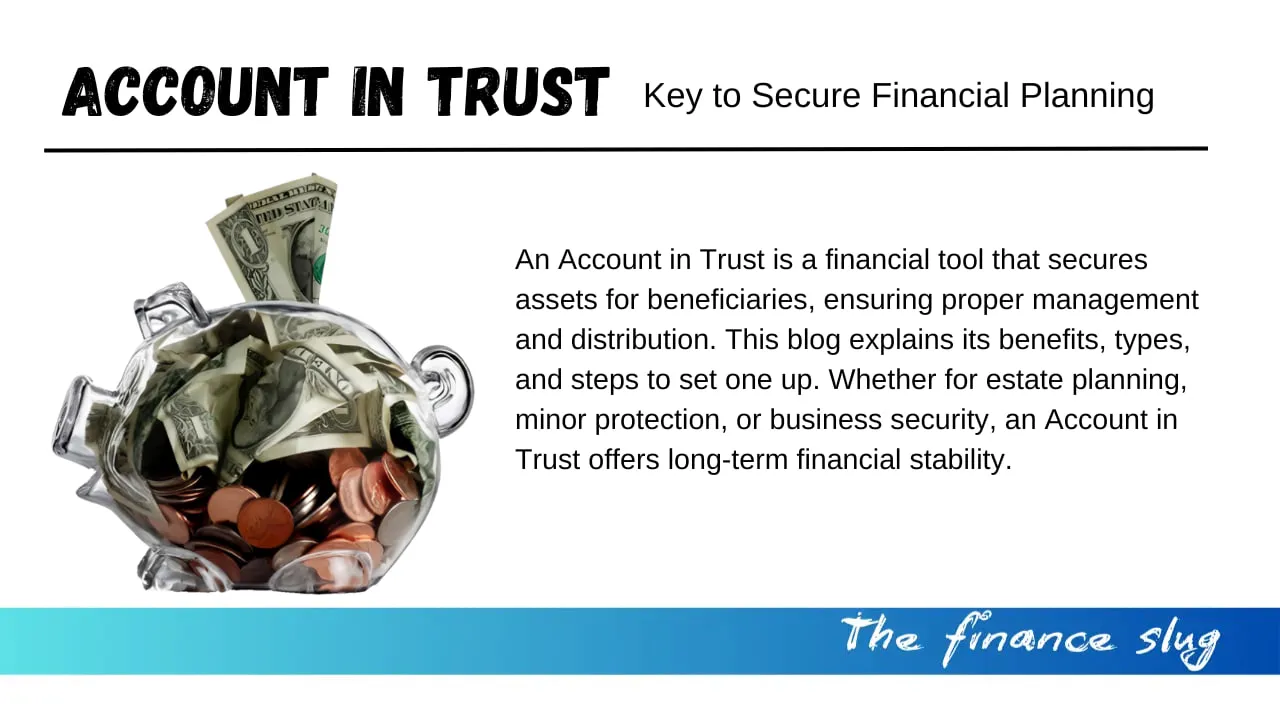
An Account in Trust is a powerful financial tool that ensures your assets are managed and distributed according to your wishes. Whether you’re planning for a child’s future, securing your estate, or protecting business funds, this type of account provides security and flexibility. It helps avoid legal complications like probate and ensures financial stability for beneficiaries. In this guide, we’ll break down everything you need to know about trust accounts, from their benefits to setting one up. Read on to discover how an Account in Trust can safeguard your wealth for the long term.
What is an Account in Trust?
An Account in Trust is a specialized financial account where one person, known as the trustee, holds and manages funds on behalf of another, called the beneficiary. This arrangement ensures that money is handled responsibly, providing financial security and peace of mind. Common uses include safeguarding assets for minors, estate planning, and business purposes.
Why Should You Consider an Account in Trust?
Opening an Account in Trust offers numerous advantages that make financial planning easier and more secure. Here’s why you might need one:
- Financial Protection for Minors – Ensures a child’s inheritance is well-managed until they come of age.
- Simplifies Estate Planning – Helps you avoid probate and ensures assets are distributed as per your wishes.
- Business Financial Management – Useful for handling business transactions, employee benefits, and partnerships.
- Charitable Giving – Allows structured financial contributions to charities while maintaining control over fund distribution.
Types of Account in Trust
1. Revocable Trust Account
This trust account gives flexibility, allowing changes or cancellation at any time. It’s ideal for those who may need to update their financial plans.
2. Irrevocable Trust Account
Once established, this trust cannot be modified, offering strong asset protection and potential tax benefits.
3. Custodial Trust Account
Designed for minors, this account safeguards assets until the beneficiary reaches adulthood.
4. Payable-on-Death (POD) Account
A simple way to transfer funds directly to a beneficiary upon the account holder’s passing, bypassing probate.
Also Read : Accidental Death Benefits: Essential Protection Your Family Needs Now
How to Open an Account in Trust
Step 1: Define Your Financial Goals
Decide why you need an Account in Trust and who will benefit from it.
Step 2: Choose a Trustworthy Trustee
Select a responsible individual or financial institution to manage the trust.
Step 3: Pick the Right Type of Trust
Choose a trust structure that aligns with your legal and financial needs.
Step 4: Open the Account
Visit a bank or financial institution, provide the required documents, and set up the trust.
Step 5: Fund the Trust
Deposit money or assets to activate the trust and begin financial management.
Also Read : Will Shiba Inu Coin Reach $1 in 2025? Huge Profit Potential
Advantages of an Account in Trust
- Asset Protection – Shields your assets from creditors, lawsuits, and financial mismanagement.
- Financial Security – Ensures your money is managed as per your directives.
- Tax Benefits – Some trusts offer tax advantages that can help reduce liabilities.
- Avoids Probate Hassles – Direct transfer of assets to beneficiaries without legal complications.
- Control Over Fund Usage – You dictate when and how the funds will be distributed.
Debunking Common Myths About an Account in Trust
1. Only Wealthy People Need a Trust Account
False! Trust accounts are valuable tools for anyone who wants to secure their financial future, regardless of income level.
2. Setting Up a Trust is Complicated
It’s actually easier than you think. With proper guidance, setting up an Account in Trust can be a smooth and hassle-free process.
3. You Lose Control Over Your Assets
Not necessarily. Depending on the type of trust you choose, you can maintain significant control over how your money is managed.
How to Manage an Account in Trust Effectively
- Regularly Review Your Trust – Ensure it continues to meet your financial objectives.
- Keep Beneficiaries Informed – Transparency prevents confusion and potential disputes.
- Seek Professional Advice – Consult financial experts to optimize trust management.
- Monitor Trust Activity – Keep track of account transactions to maintain oversight.
Also Read : Gomyfinance.com Saving Money Tool: Save money like Pro
Final Thoughts
An Account in Trust is a practical and effective way to secure your assets while maintaining control over their use. Whether for estate planning, minor protection, or business security, trust accounts provide long-term financial stability.
Now is the perfect time to take charge of your financial future. Consider setting up an Account in Trust today and ensure your wealth is in safe hands!
FAQs
1. Who can open an Account in Trust?
Anyone, including parents, guardians, business owners, and estate planners, can open a trust account to safeguard assets for beneficiaries.
2. What are the benefits of an Account in Trust?
It helps with estate planning, avoids probate, protects minors’ finances, provides tax benefits, and ensures financial security for the future.
3. How do I set up an Account in Trust?
Choose a trustee, define your goals, pick the right trust type, open the account with a financial institution, and fund it with assets.
4. What is the difference between a revocable and irrevocable trust account?
A revocable trust allows changes, while an irrevocable trust cannot be modified, offering greater asset protection and tax benefits.
5. Can I withdraw money from an Account in Trust?
It depends on the trust type. Revocable trusts allow withdrawals, while irrevocable trusts restrict access based on predefined terms.
6. What happens to an Account in Trust after the trustee passes away?
A successor trustee, appointed in the trust agreement, takes over and ensures the assets are managed or distributed according to the trust terms.
Stock Market Crash Today: A Bloodbath on Monday – What You Need to Know
Published on financeslug.xyz The global financial markets are reeling from a massive sell-off, and Indian…
Wall Street Bonuses Reach Record $47.5 Billion in 2024, Up 34% from Previous Year
How to Convert Delimited CSV Data into Columns in Excel
CSV (Comma-Separated Values) files are widely used for data exchange, but when opened in Excel,…
Harvard University Announces Free Tuition for Families Earning $200K or Less
Harvard’s New Tuition-Free Policy: What You Need to Know Harvard University has unveiled a groundbreaking…
Eli Lilly’s 1.8B Dollar Investment in Weight Loss Drugs
Ireland’s Weight-Loss Drug Boom: A Game-Changer for Economy and Healthcare Ireland is witnessing a surge…
Forever 21 Files for Bankruptcy Again: The End of an Era in Fast Fashion?
Forever 21, once a staple in American malls and a leader in the fast-fashion industry,…







